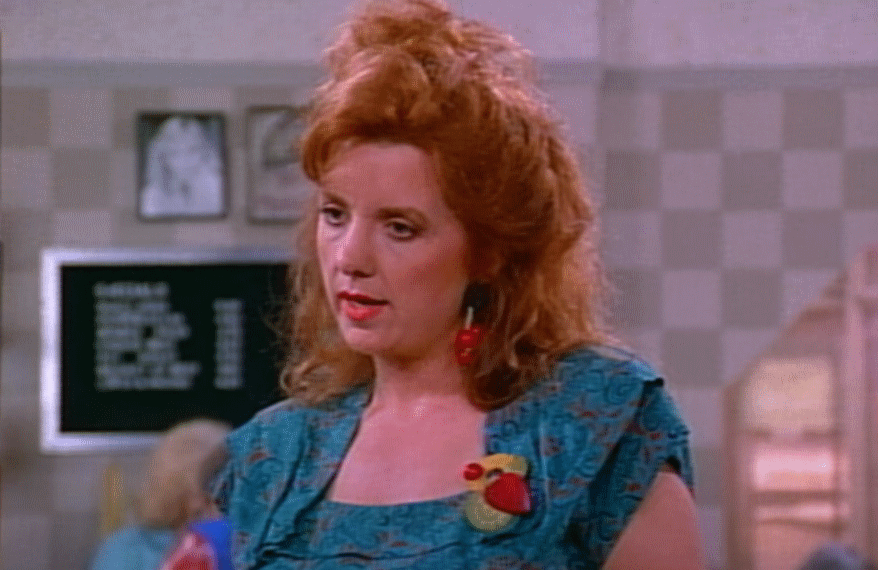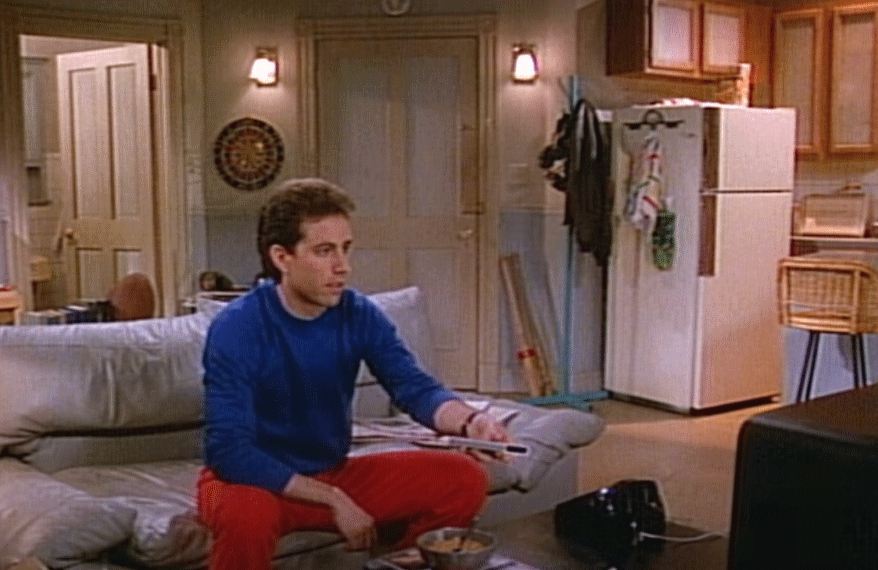Revisiting the Seinfeld Pilot: What Stuck and What Got Dropped
-
 Jerry and George were there from the jump. Jerry Seinfeld and Jason Alexander in the Seinfeld pilot.
Jerry and George were there from the jump. Jerry Seinfeld and Jason Alexander in the Seinfeld pilot.In this recurring Primetimer feature, we look back at pilot episodes of some of the most culturally sticky TV shows of all time to see what changed and evolved from the original concept, and what was present from the jump.
Seinfeld is one of television’s most acclaimed shows, and produced some of the most iconic standalone sitcom episodes in the genre’s history, including “The Contest,” “The Parking Garage,” and “The Rye.” "The Strike" introduced Festivus to the rest of us, while "The Boyfriend" managed to use JFK assasination conspiracy theories as a template for an encounter between Kramer, Newman, and the Mets' Keith Hernandez.
While it ended its run as the number-one show on television, it took some time to get there. It also took time to actually start. Seinfeld’s pilot was deemed such a mess that NBC decided to pass on the series, thanks in part to poor reception from test audiences. But the network aired the pilot in the summer of 1989, and critics and viewers responded well, leading NBC to pick up the show.
Its second episode wouldn’t premiere until May 31, 1990. While most pilot episodes are filmed in spring, giving network executives, producers, and writers a few months to make adjustments before production begins in the summer, Seinfeld had almost a full year between its pilot and the beginning of its first season. That may account for how different the pilot is from the series. While the core of the show is evident in the pilot, a lot of what surrounded it was changed.
THE SHOW: Seinfeld
THE EPISODE: "The Seinfeld Chronicles" (aka “Good News, Bad News” and “Pilot”)
AIR DATE: July 5, 1989The Plot
Stand-up comedian Jerry has met Laura (Pamela Brull) while traveling, and she’s called him to say she’s on her way to New York. The entire episode focuses on whether or not intentions are romantic. But Laura herself is only in a small part of the episode, at the end, and mostly to reveal that she’s actually engaged, and thus all of Jerry’s assumptions have been wrong. The episode’s focus, then, is on two friends, Jerry Seinfeld and George Costanza, who are analyzing and over-analyzing her past and future behavior, trying to discern her intentions. While waiting at the airport gate for her to arrive, Jerry compares this process to “a murder investigation”: “Wouldn’t it be great if you could ask a woman what she’s thinking?” he asks. “Instead, I’m like a detective. I gotta pick up clues.” That’s a good description of what we learn about the show over the course of the episode.
Show Thesis on Display
“It’s about nothing. Forget the story,” George tells Jerry about the sitcom they’ll eventually pitch to NBC in a very meta season-four arc. That may have been what some viewers or critics thought about Seinfeld compared to other plot-heavy situation comedies, but it was never really true of Seinfeld The show shares its characters’ fascination with the minutiae and anxieties of daily life, and those are very evident in the pilot, from the opening discussion about the buttons on George’s shirt to George and Jerry’s analysis of Laura’s potential greetings.
Rough Edges
There are only fragments of Seinfeld in the pilot, and that starts with the soundtrack. The original pilot had very different music, as you can hear above. After its initial airing it was replaced with the more familiar slap bass theme, which is augmented with composer Jonathan Wolff’s vocalized pops.
The first episode is surprisingly linear, which only feels rough compared to future episodes. Eventually Seinfeld became well-known for introducing several threads and then pulling them together at the end. Instead of an A story and B story, a major and minor plot, Seinfeld’s best episodes introduce several storylines, and then surprisingly but organically connect them all together, sometimes in a neat bow, sometimes weaving the threads together into something new. But the pilot has no sign at all of the show’s iconic structure, which took a while to develop.
The pilot doesn’t even have a B story, which may explain why it over-relies on Jerry Seinfeld’s stand-up, returning to it repeatedly throughout the episode. Those stand-up segments would later be relegated to the cold open and end of the episode before being dropped entirely. In Jerry’s stand-up, like so much of 1990s humor, there’s a lot of anxiety about gender roles. He talks about women using cotton balls, as if a man would never ever do such a thing, and also expresses complete confusion about women ("I swear. I have absolutely no idea what women are thinking"), defining them as objects for men to acquire (“What do men want? We want women, that’s it.”). In the pilot, both the characters and the show treat women as mysteries, rather than actual human beings.
There From the Jump
Seinfeld’s banter, the anxiety, the lack of empathy for other people, the lack of character growth or change: all of that is in the pilot. So are the show’s sometimes-successful, sometimes-not attempts to label people or behaviors. “Be a come-with guy,” Jerry tells George in the pilot, which did not catch on like “yadda yadda yadda” or “not that there’s anything wrong with that.
Jerry and George’s characters are well-established, probably because they’re based on co-creators Jerry Seinfeld and Larry David. There are minor details that change, like George being in real estate, but the characters themselves are established. Foreshadowing a future arc for his character, George tells Jerry to ignore his instincts: “always, always do the opposite.” While Michael Richards’ character is named “Kessler,” he does very Kramer things, such as popping into Jerry’s apartment looking for food, injecting himself into Jerry’s life, in this case accidentally spoiling the Mets game that Jerry is watching on tape.
Dropped Entirely
The pilot and the second episode seem like versions of the same show from different timelines, that’s how much is different. But there were three major changes.
First, Claire, a snarky server at Pete’s Luncheon played by veteran actor Lee Garlington, was originally the fourth member of the show’s ensemble. But for the series, both Claire and Garlington were dropped. Garlington was replaced by Julia Louis-Dreyfus, who plays an entirely different character, Jerry’s friend and ex Elaine Benes. (In an interview with HuffPost, Garlington said, “They didn’t pick up my contract,” and “It didn’t bother me the first five years. [Laughs.] But the second five years drove me nuts. I don’t know why.”)

The other major changes involve names: Kramer’s and Seinfeld’s. “Kessler” becomes “Kramer” (and of course, his first name, Cosmo, wasn’t be revealed until season six), while The Seinfeld Chronicles dropped “The” and “Chronicles” to just become Seinfeld.
As the series went on, a lot about Kramer changed, including his appearance, his entrances, and his character. “You haven’t been out of the building in ten years,” Jerry tells Kessler in the pilot, suggesting his character is supposed to be agoraphobic. That’s a character trait that was retained for a while — Kramer is not in one of the series’ early iconic episodes, “The Chinese Restaurant,” for example — but is eventually dropped. Among many other ventures in the outside world, Kramer pursues an acting career, which takes him to Los Angeles where he’s suspected of being “The Smog Strangler” serial killer.
While this isn’t a pilot to series change, it’s notable that Jerry’s parents Morty and Helen appear in the second episode, but the actor who plays Morty, Phil Bruns, was recast after his first appearance, and replaced by Barney Martin.
The Set(s)
There are two major locations in Seinfeld: Jerry’s apartment and Monk’s, a local diner. Jerry’s apartment retains much the same layout after the pilot (plus or minus the hall to Jerry’s bedroom), although its decor changes almost entirely. In the pilot it’s much more of the 1980s, and even a little bit Golden Girls, with wicker bar stools and a wicker room divider, and Mets paraphernalia. In episode two, the apartment gets a modern makeover and a new exterior (in Los Angeles, as it turns out).

While the show opens with George and Jerry at a diner, it’s not Monk’s, on either the interior or exterior. The establishing shot tells us they’re at Pete’s Luncheonette, which is actually a location in The Muppets Take Manhattan, a restaurant where Miss Piggy is a server and Kermit is a dish washer. (They’re not in the Seinfeld pilot. The building is actually in New York City, and is a McDonald’s today.) The interior of the diner is also quite different: Jerry and George are sitting at a round table, and the decor includes a neon I (Heart) NY neon sign in the window, and framed black and white photos of celebrities on the walls. In subsequent episodes, the show switches to Monk’s with its counter and booths. For exterior shots, the show moves away from Muppet movies and instead uses the real-life “Tom’s Restaurant” near the campus of Columbia University.
All nine seasons and 180 episodes of Seinfeld are now streaming on Netflix.
Andy Dehnart is a writer, TV critic, and teacher who reviews and reports about reality TV at reality blurred.
TOPICS: Seinfeld, Jason Alexander, Jerry Seinfeld